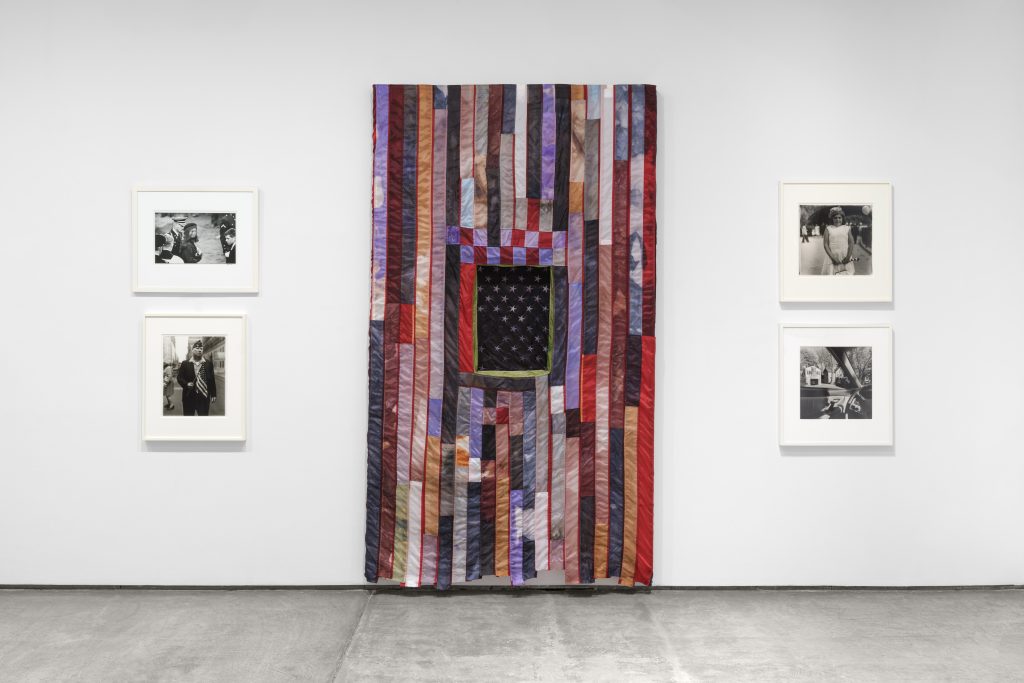The American flag felt remarkably alive — present as a thing, a conceptual figure stationed throughout history with which to engage — in “Flags: A Group Show” at Paula Cooper Gallery, New York.
Nods to the American flag are the through-line in the exhibition, which spotlights nearly four dozen different artists but is cohesive, through and through.
Expanding the American Flag’s Footprint
The included artists challenged the concept of the United States’ flag as a conceptually stationary object with a straightforward interpretation.
In truth, communities outside the country and groups right here within it have experienced subjugation and destruction under the banner — the flag — of the U.S., whether that’s the abhorrent stain of slavery and subsequently persistent racism domestically or the conflicts in which the country’s government involved itself or spurred, repeatedly to substantial tides of outrage from everyday Americans living here.
Conversely, marginalized groups fought and continue fighting for recognition, rights, and respect under the American system — and its flag, and though there is an unproductive stereotype of those raising criticisms of the U.S. being fundamentally opposed to it (anti-American, essentially), the artists in this group exhibition don’t disregard or dump the flag or what it represents. But the flag, in these artists’ hands, wavers and stumbles under the weight of what is historically — and at the very least, for these artists — associated with the symbolism.
They’re creating a kind of accountability, combined with a reimagining of history itself and possibilities for the future, showing the flag in a variety of always pointed lights that suggest (or very directly reference) alternative interpretations for its presence and involvement in our personal and collective lives. Refreshed visions that promise a greater sense of accuracy in reflecting actual experiences.
And though obviously, an exhibition this wide-ranging treks through an extensive list of specifics, that’s a key, guiding light here: close attention to personal experience. Whether adeptly more confrontational or more quiet and restrained, these artists are showcasing something you get the sense is what the American flag really, actually means to everyday people for whom it’s supposed to be, strictly traditionally speaking, a beacon. Often, it has fallen short — though there was a lot of refined weight to the reappropriation of the red, white, and blue throughout this showcase.
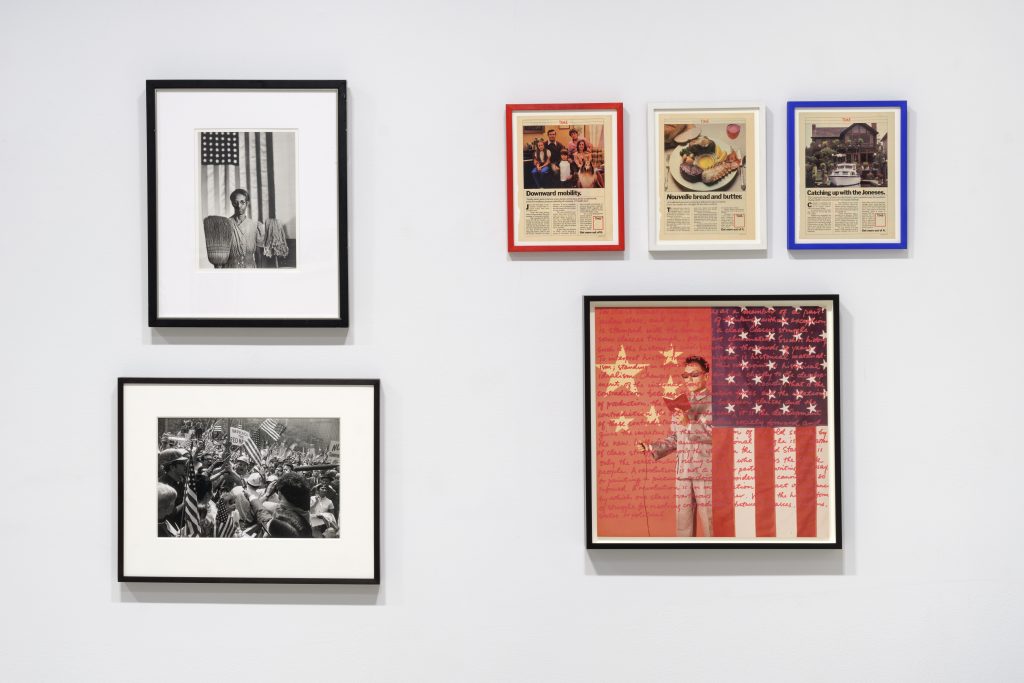
Claes Oldenburg, David Hammons, & More
Many of the exhibition’s artworks quite directly incorporate the American flag’s imagery but reshape it.
“Bunting” (1961) by Claes Oldenburg — comprised of muslin soaked in plaster over a wire frame and painted with enamel — features broad swathes of red, white, and blue, not directly reproducing the flag but obviously referencing it in a newfangled mash-up. It recreates the flag as a bleeding, viscous force via the particular textures that Oldenburg utilized combined with the dramatic but artfully imperfect rhythm created by the linkage of color and physicality.
You could even see desperation in this particular vision of the flag: an urgency, a suddenly exploding rallying cry meant to be enveloping but ending up a (cultivated) mess.
Meanwhile, David Hammons’ “African-American Flag” (1990) maintains much more of the aesthetic structure of the original American flag itself, redoing the color palette. The stars, for instance, are now black on a background of pointed green. It utilizes a combination of colors associated with the Pan-African Universal Negro Improvement Association, the Museum of Modern Art, which also has one on display, explains.
And the familiar, sing-song tonality created by moving from horizontal bar to horizontal bar here creates something distinctly majestic: a far-reaching rallying cry that will reverberate with persistence and clarity.
“© 2004 Hasbro Inc.” (2015) by Rachel Harrison was another standout. It is an assemblage on a cart, the particular arrangement of materials evoking a human figure, atop which an American flag-emblazoned hard hat was placed. There’s also a toy gun and fake sausages.
Taken as a whole, the artwork suggested the intermixing of an assumption of innocence with an assumption of violence. Though a bit large, at just over five feet tall, the visual combination of the included components is more of an everyday chaos than a forceful, sweeping drama — but the plastic gun plopped in the middle of it all suggests a situation that already got away from you. It’s a self-replenishing, self-propelling system in place and ready to move.
Again and again, the artworks in this exhibition were showcases of striving — some more dramatic than others, but consistently focused on what for each artist was the here and now, from start to finish sticking to a personalized vantage point. An expression of a moment.
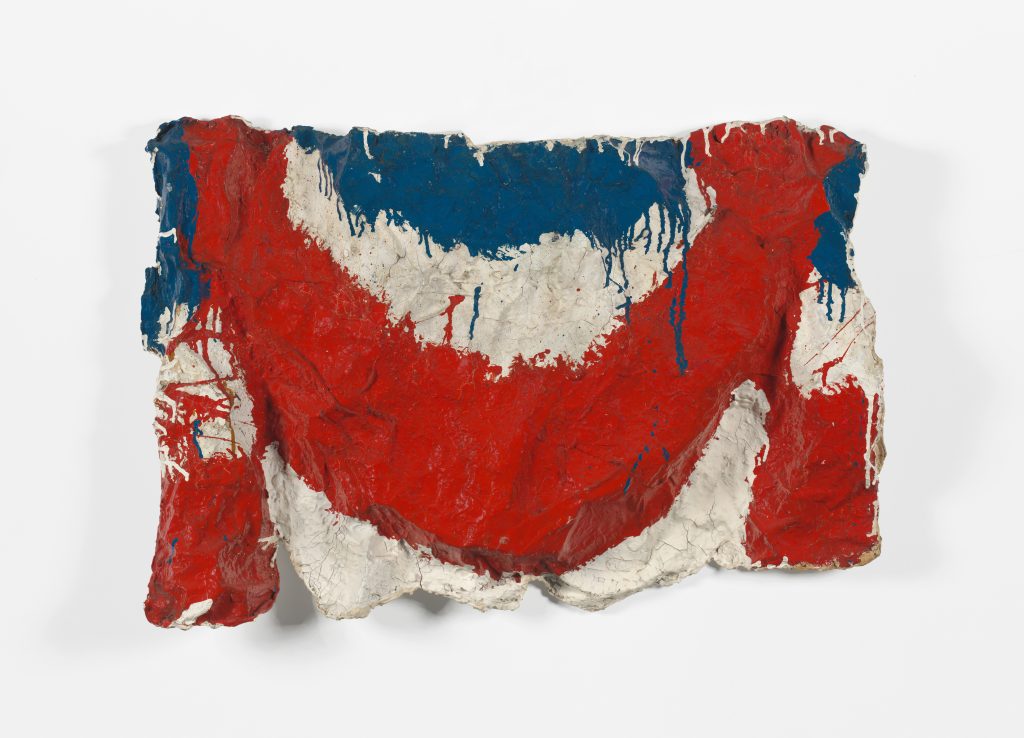
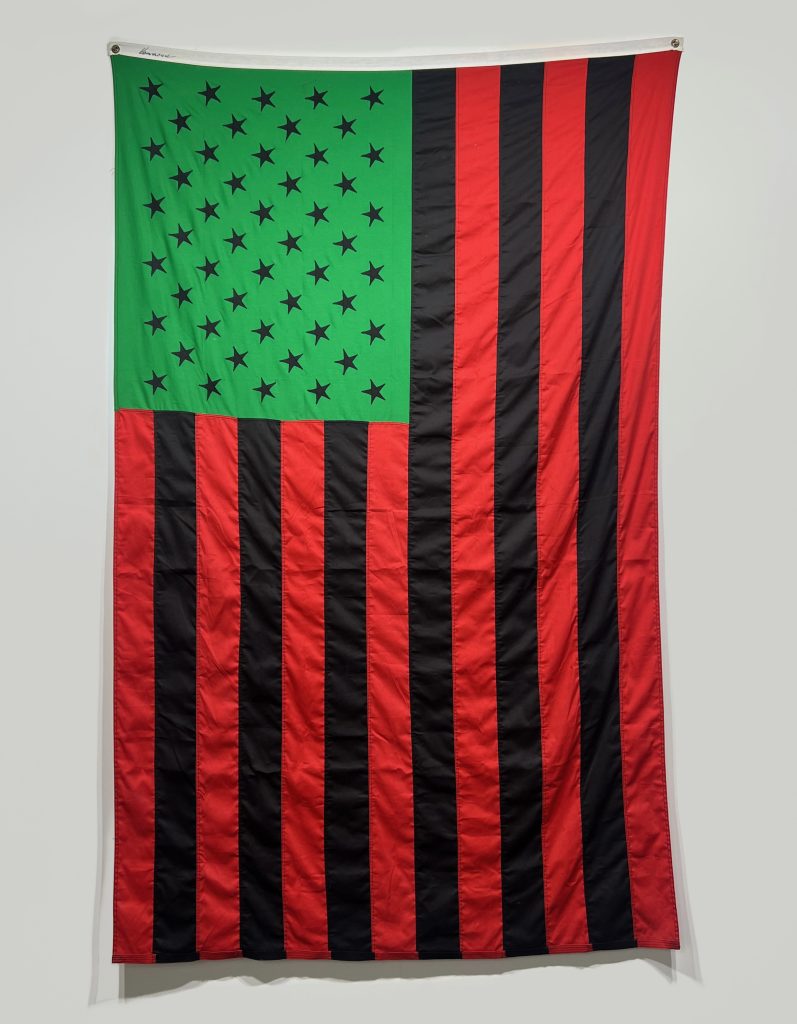
Stumbling, but Continuing to Strive
Multiple other fascinating pieces by Oldenburg were also in the exhibition: particularly, a couple of relatively small constructions identified as comprised of found wood and nails and then wood, respectively.
“Lighthouse Flag Provincetown” (1960) and “The Old Dump Flag” (1960) both presented the vague outline of American flags — the latter even using shaped pieces of wood clearly meant originally for something else to invoke the horizontal bars. But you got the sense that the flag concept here was (intentionally) falling apart: a symbol, perhaps, of the stubborn, relentless reliance on it and its reproductions in some corners. Oldenburg adeptly upturned its ever present imagery.
Also in the exhibition was “Three Flags in the Winter 5 Dic. 1962” (1986) by collage artist Nancy Grossman, which assembled a range of papers with ink and watercolor on Masonite. The flag appears here as postage stamps.
Again, you were left with a sense of an unfolding strive, a push, a marathon run a little bit at a time rather than all in one big burst.
The assembled papers, some on the smaller side, joined each other and grew into something subtly majestic and sweeping. The tone of Grossman’s collages varies considerably, but this one reminded me in its spatial arrangement of a desk drawer, or the top of a desk covered in papers, some eventually of uncertain origin as minutes, hours, and days speed by. But it was persistent. The particular facet of that real-world set-up to which the piece pointed was how one might lean into perseverance, returning day after day to a workspace, a home office, or just a household, keeping it going.
It’s the kind of strength often associated with the flag and the underlying national mythos — something for these artists and so many others, not always reached. But they’re looking forward.
“Flags: A Group Show” remains on view at Paula Cooper Gallery, New York through October 26.
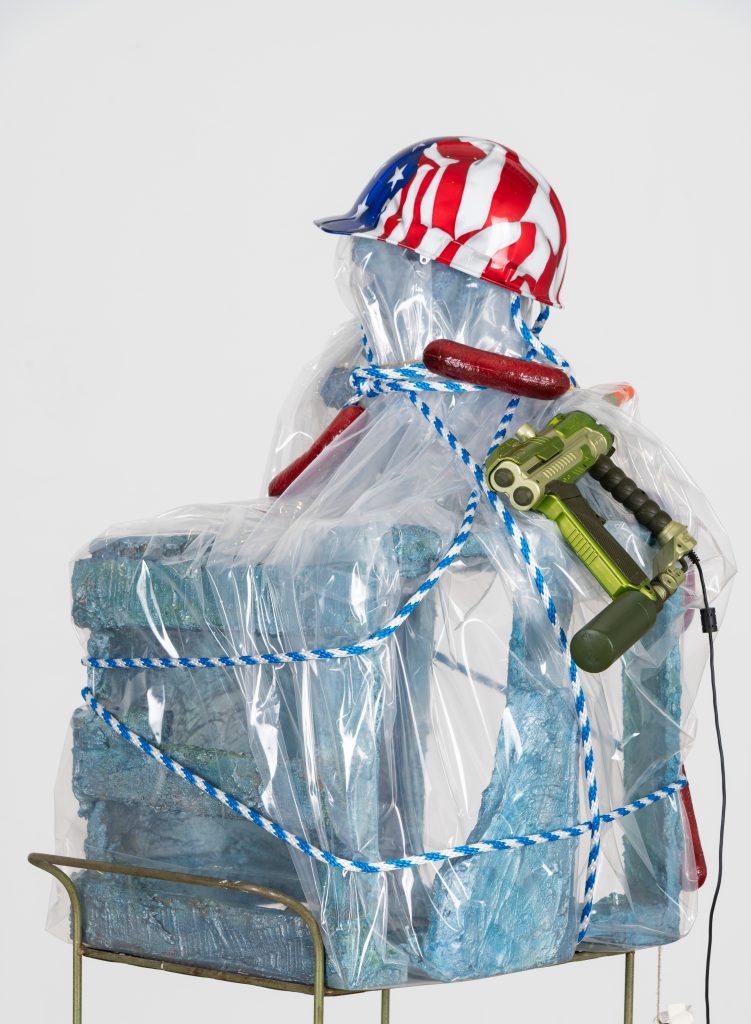
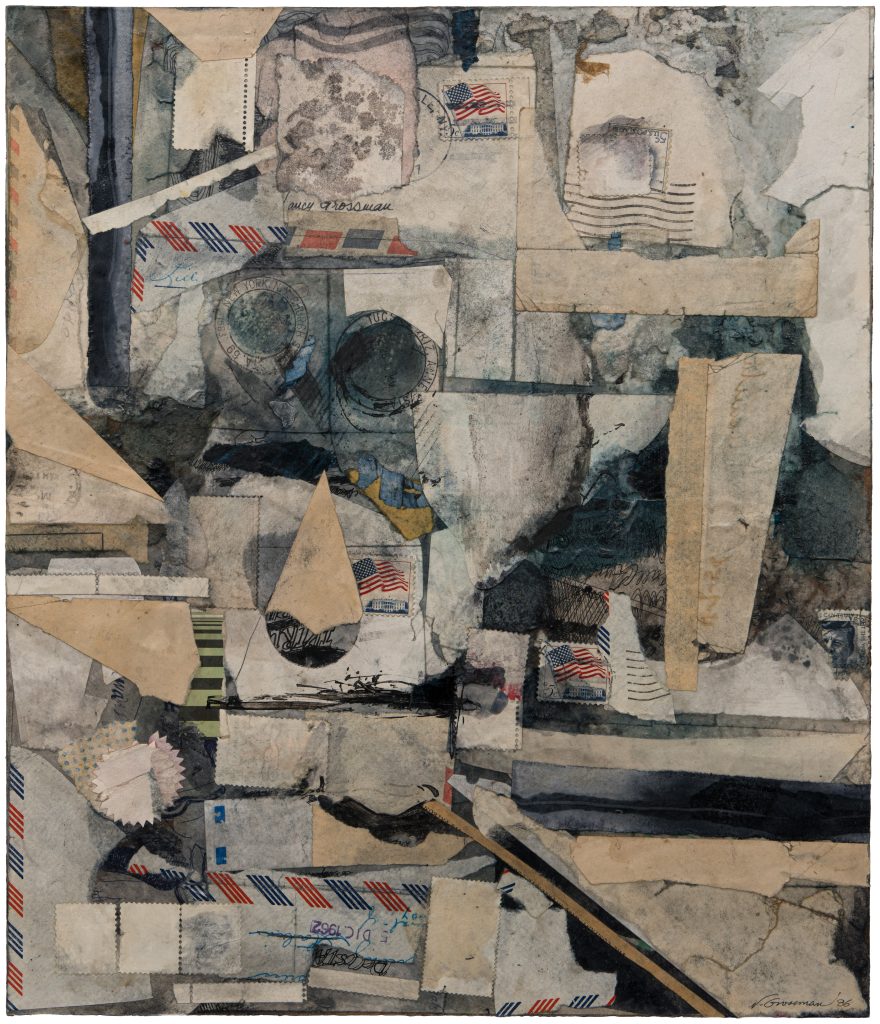
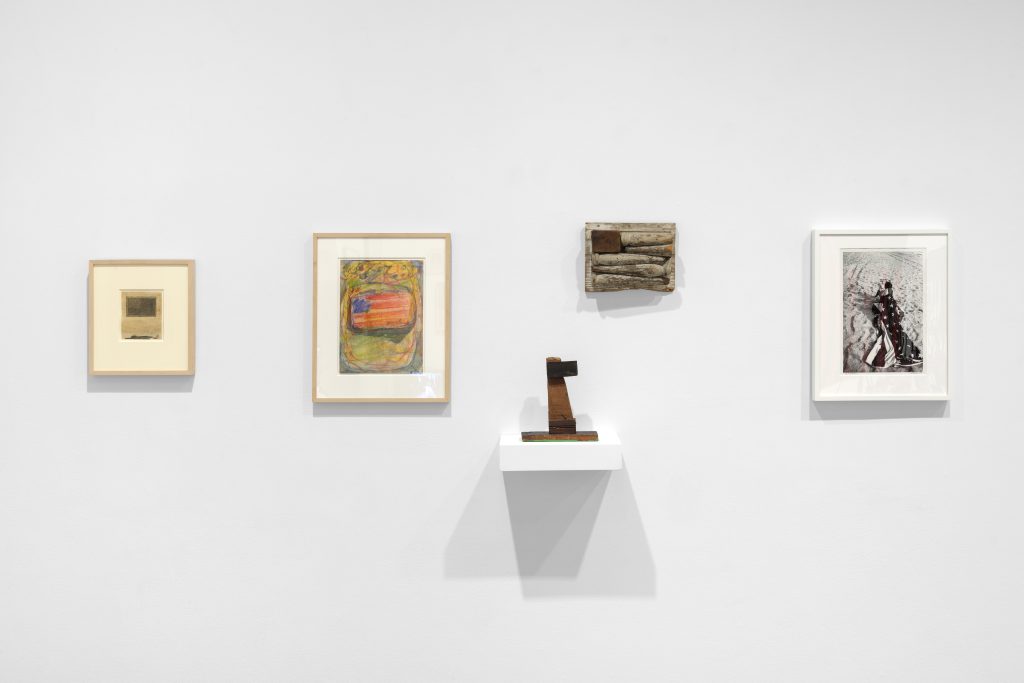
Featured image: Installation view, “Flags: A Group Show,” Paula Cooper Gallery, New York, September 7 – October 26, 2024. Courtesy Paula Cooper Gallery, New York. Photo: Steven Probert.
You may also like
-
Diana Kurz at Lincoln Glenn in New York: A Review of a Shining Art Exhibition
-
Dustin Hodges at 15 Orient in New York City: An Ensnaring Exhibition at an Exciting Gallery
-
Maren Hassinger at Susan Inglett Gallery in New York: Reviewing an Uplifting Art Exhibition
-
Enzo Shalom at Bortolami in New York City: Reviewing an Entrancing Exhibition of Paintings
-
“Ben Werther: Townworld” at Amanita in New York City: Reviewing a Richly Memorable Art Exhibition
